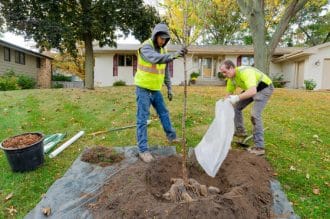Thirty-five Minnesota communities received a collective $2.4 million boost in their ability to protect urban forests thanks to funding provided by the Minnesota Environment and Natural Resources Trust Fund as recommended by the Legislative-Citizen Commission on Minnesota Resources. The grant program began in 2022 and runs through June 2025.
Communities will use the funding from the Protect Community Forests by Managing Ash for EAB Grants Program for tree inventories, management plans, ash tree removal, treatment with non-neonicotinoid insecticides, tree planting, and materials to support newly planted trees, such as staking, water bags, and mulch.
“Minnesota’s cities and towns contain a significant number of ash trees, which are now at risk of attack by the emerald ash borer, a non-native insect,” said Emma Schultz, Minnesota DNR Community Forestry grant specialist. “This destructive beetle can kill ash trees in just a few years, and all ash trees in the state are at risk of infestation.”
Identifying infected or at-risk trees and addressing EAB-related challenges is an obstacle for many communities. The grants will help recipient communities take preemptive measures that are more cost-effective than waiting for ash trees to become infested.
For example, the city of Aitkin will use its grant award to manage better the community trees that improve residents’ quality of life and contribute to the natural setting that draws visitors to the area, which is essential for the local economy.
“The city of Aitkin is now starting to understand its community forest and the resources necessary to manage them properly,” said Troy Holcomb, Minnesota DNR forester. “Tax bases are smaller in greater Minnesota, and city staff and budgets must focus on meeting basic community needs like sewer service and usable streets. This grant money allows the city to perform a tree inventory and create a management plan. The city can work smarter and target the most needed limited resources. Being proactive is easier and more affordable than being reactive.”
In Rochester, where EAB was first discovered in 2015, ash comprised 15% of the estimated 100,000 public trees.
“EAB has drastically changed how our urban forest looks,” said Alison Litchy, Urban Forestry program coordinator in Rochester. “Fortunately, we can treat and maintain treatments for approximately 4,000 public ash trees through the help of this grant. Preserving these trees through treatment allows us to retain the canopy of 8% of our public tree population. The retained trees benefit our community by reducing temperatures, capturing air pollutants, and slowing down stormwater during this great loss. We use non-neonicotinoid insecticides and knowledgeable, certified arborists to treat trees to protect pollinators and other non-target organisms.”
EAB has been confirmed in 41 of Minnesota’s 87 counties. For a list of these counties, visit the Minnesota Department of Agriculture’s interactive map (tinyurl.com/mnag-eab-map).
The next round of grant funding is anticipated to open by August 2023, with more than $16 million available. Interested applicants should visit the Minnesota DNR’s Community Forestry webpage (mndnr.gov/forestry/urban) or contact the Minnesota DNR Community Forestry Grants Team at ucf.dnr@state.mn.us.





